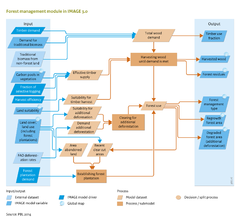Forest management/Description: Difference between revisions
Jump to navigation
Jump to search
No edit summary |
No edit summary |
||
| Line 1: | Line 1: | ||
{{ComponentDescriptionTemplate | {{ComponentDescriptionTemplate | ||
|Reference=Kallio et al., 2004; FAO, 2001a; FAO, | |Reference=Kallio et al., 2004; FAO, 2001a; FAO, 2008; Brown, 2000; Carle and Holmgren, 2008; FAO, 2012a; FAO, 2012b; FAO, 2010; | ||
|Description=The forest management module describes regional timber demand and the production of timber in the three different management systems clear felling, selective felling and forest plantations. Deforestation rates reported by {{abbrTemplate|FAO}} are used to calibrate deforestation rates in IMAGE, using a so called additional deforestion. | |Description=The forest management module describes regional timber demand and the production of timber in the three different management systems clear felling, selective felling and forest plantations. Deforestation rates reported by {{abbrTemplate|FAO}} are used to calibrate deforestation rates in IMAGE, using a so called additional deforestion. | ||
===Timber demand=== | ===Timber demand=== | ||
In IMAGE 3.0, the driver for forest harvest is timber demand per region. Timber demand is the sum of domestic and/or regional demand and timber claims by other regions (export/trade). Production and trade assumptions for saw logs and paper/pulp wood are adopted from external models, such as [[ | In IMAGE 3.0, the driver for forest harvest is timber demand per region. Timber demand is the sum of domestic and/or regional demand and timber claims by other regions (export/trade). Production and trade assumptions for saw logs and paper/pulp wood are adopted from external models, such as [[EFIGTM model|EFI-GTM]] ([[Kallio et al., 2004]]), and domestic demand for fuelwood is based on the [[TIMER model]] (See Component [[Energy supply and demand]]). | ||
Part of the global energy supply is met by fuelwood and charcoal, in particular in less developed world regions. Not all wood involved is produced from formal forestry activities, as it is also collected from non-forest areas, for example from thinning orchards and along roadsides ([[FAO, | Part of the global energy supply is met by fuelwood and charcoal, in particular in less developed world regions. Not all wood involved is produced from formal forestry activities, as it is also collected from non-forest areas, for example from thinning orchards and along roadsides ([[FAO, 2001a]]; [[FAO, 2008]]). As few reliable data are available on fuelwood production, own assumptions have been made in IMAGE. While fuelwood production in industrialized regions is dominated by large-scale, commercial operations, in transitional and developing regions smaller proportions of fuelwood volumes are assumed to come from forestry operations: 50% and 32% respectively. | ||
===Timber supply & production in forests=== | ===Timber supply & production in forests=== | ||
| Line 18: | Line 18: | ||
===Additional deforestation === | ===Additional deforestation === | ||
Globally, conversion to agricultural land is the major driver of forest clearing, and timber harvest does not result in deforestation, if natural vegetation is regrowing. But there are other causes of deforestation not related to food demand and timber production, such as urbanisation, mining and illegal logging. These activities contribute to loss of forest area, increased degradation risks and a decline in the supply of forest services. To be consistent with the total deforestation rates per world region reported by the FAO ([[FAO, 2010|2010]]), IMAGE 3.0 introduces a category ‘additional deforestation’. IMAGE assumes no recovery of natural vegetation in these areas, and no agricultural activities. | Globally, conversion to agricultural land is the major driver of forest clearing, and timber harvest does not result in deforestation, if natural vegetation is regrowing. But there are other causes of deforestation not related to food demand and timber production, such as urbanisation, mining and illegal logging. These activities contribute to loss of forest area, increased degradation risks and a decline in the supply of forest services. To be consistent with the total deforestation rates per world region reported by the FAO ([[FAO, 2010|2010]]), IMAGE 3.0 introduces a category ‘additional deforestation’. IMAGE assumes no recovery of natural vegetation in these areas, and no agricultural activities. | ||
|Flowchart=ForestManagementModel.png | |Flowchart=ForestManagementModel.png | ||
|AltText=Component flow chart forest management | |AltText=Component flow chart forest management | ||
Revision as of 15:08, 21 May 2014
Parts of Forest management/Description
| Component is implemented in: |
| Components: |
| Related IMAGE components |
| Projects/Applications |
| Key publications |
| References |
